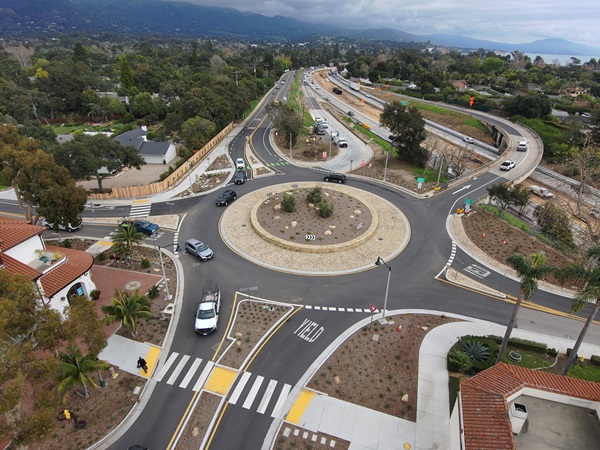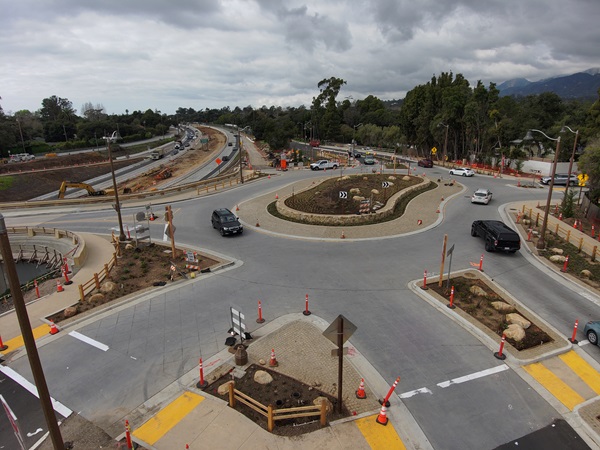All-in-one version
Director’s Corner
Annual ceremonies put a spotlight on safety
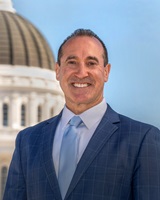
Tony Tavares
Hello, Caltrans family. The recent tragedy in Baltimore’s harbor, where a ship-caused collapse of the Francis Scott Key Bridge claimed the lives of six roadway workers, was an unwelcome reminder that the transportation industry has its perils.
We are reviewing what happened in the early hours of March 26 in Maryland and will address any findings that might help increase bridge safety in California.
Caltrans works hard to guarantee that our state’s many bridges meet rigorous seismic and safety standards. Fender systems are installed on all major bridges, which means that bridge piers are protected from the unlikely and rare event of being struck by marine traffic. All state-owned bridges are regularly inspected to ensure strict structural safety and have been seismically retrofitted to the highest national standards.
Safety – one of the four foundational principles of our department, along with equity, climate action and economic prosperity in all communities – must remain our top priority and can never be taken for granted.
Each spring we put a ceremonial, emotional emphasis on safety by paying tribute to those California highway workers who died on the job. Since 1921, there have been 193 such fatalities.
This year’s statewide Fallen Workers Memorial will be held at 11 a.m. Thursday, April 25, on the west side of the State Capitol building in downtown Sacramento. The sober, moving event allows us to formally remember those who lost their lives building, maintaining and operating California’s world-class transportation system. The observance also honors our fallen contractors and highlights transportation safety awareness for all, including the traveling public.
The memorial is held in conjunction with Caltrans Safety Awareness Week and highlights the importance of motorist and employee work zone safety. Attendance at this remembrance, or your local Workers Memorial, can satisfy the two-hour requirement for Safety Awareness Week participation.
We hope that you take the time to attend one of the memorials being held throughout the state, either virtually or in person, as we honor those who lost their lives on the job. Here is the schedule:
District 1: Wednesday, May 8 in Eureka
District 2: Tuesday, May 7 in Red Bluff
District 3: Thursday, April 25 at the State Capitol
District 4: Tuesday, May 28 in Benecia
District 5: Tuesday, April 30 in San Luis Obispo
District 6: Wednesday, May 8 in Visalia
District 7: Thursday, May 9 in Commerce (tentative)
District 8: Wednesday, May 8 in San Bernardino
District 9: Thursday, May 2 in Mojave
District 10: Thursday, April 25 at the State Capitol
District 11: Tuesday, April 16 in San Diego
District 12: Wednesday, April 17 in Orange
Thank you for all you do to advance the goal – the necessity – of making travel in our state safe for everyone.
News
An inside look at a District 2 bridge

District 2 photograph
By Haleigh Pike
District 2 public information officer
The Antlers Bridge, which carries Interstate 5 traffic over the Sacramento River Arm of Shasta Lake, is one of the largest bridges in District 2, but there is one more thing that helps it stand out that many don’t know about. You can go inside it!
The first of its kind in District 2, the Antlers Bridge was constructed to include an enclosed box girder that is essentially a tunnel that runs right under the surface of the bridge deck, allowing easier access for inspections and repairs. Inside the enclosed box girder is a crane, hoist and lighting system, installed to help make inspections and repairs easier during the bridge’s 100-year design life.
For 74-years, the former 1,328-foot-long Antlers Bridge carried traffic but its active fatigue cracks and degrading deck made the bridge an annual drain on the State’s maintenance resources, including the District 2 Bridge Crew. In September of 2016, the original bridge was retired and traffic was moved to the new 1,942-foot-long bridge which was constructed adjacent to the old bridge.
The District 2 Bridge Crew inspects the Antlers Bridge every two years but additional inspections are occasionally required if the crew is notified of issues with the 16 seismic monitors placed throughout the bridge structure.
According to Chris Traina, Chief of the Division of Engineering Services, these monitors are maintained and operated by the California Geological Survey (CGS)through an interagency agreement between Caltrans and the Department of Conservation. In addition to providing information following earthquakes in ourarea, CGS also “pings” the sensors monthly to ensure everything is in working order.
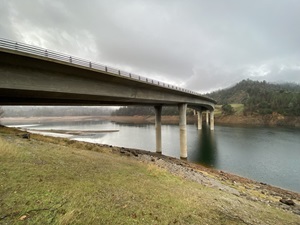
District 2 photograph
Another aspect to inspecting the bridge is ensuring all the internal equipment is operating correctly including the crane, hoist and lighting. This requires the assistance from an electrician, which is not usually required for a bridge inspection.
Overall, the new Antlers Bridge requires significantly less maintenance resources and according to Billy Shakespeare, the District 2 Bridge Crew Supervisor, all maintenance will be easier as well. “The old Antlers Bridge was a fracture critical structure with a lot more maintenance to perform on the steel rivets, bolts, and components needing replacement as they fatigued butwith the way the new bridge was constructed, eliminating the streel truss support, we’re spending a lot less time on this bridge and do not expect it to require significant maintenance over the years,” said Shakespeare.
The Antlers Bridge was completed in 2016 and this historic project was celebrated by installing a time capsule, with photos and personal items from those involved in the construction of the bridge, within the enclosed box girder. The capsule is scheduled to be opened in 2043, 100 years from the completion of the Shasta Dam.
Progress is on a roll with state's rail network
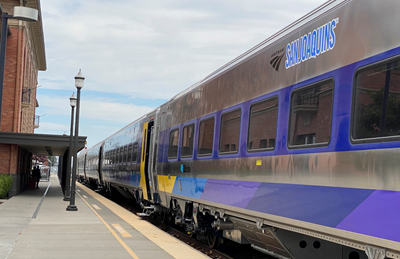
Headquarters photograph
By Rick Brewer
Headquarters Public Affairs
Train passengers traveling in Northern California and the Central Valley will be able to enjoy a more comfortable and modern ride with the launch of new Venture Passenger Rail Car trains unveiled during a Caltrans and San Joaquin Regional Rail Commission event on March 5 at the Stockton Regional Maintenance Facility.
The single-story, fully ADA-accessible passenger cars provide wider aisles, accessible restrooms and fully-automated doors, continuing California’s expansion of comfortable and convenient options for travelers and commuters.
“Our goal is to make traveling throughout our beautiful state by train as accessible, convenient and comfortable as possible, and these new train cars have us on the right track,” said Toks Omishakin, California State Transportation Agency (CalSTA) secretary. “I thank the Federal Railroad Administration, San Joaquin Joint Powers Authority, San Joaquin Regional Rail Commission, Siemens, Sumitomo Corporation of Americas, and our many other partners who have worked tirelessly over the years to help improve passenger train travel for all Californians.”
“These trains are a giant leap forward in passenger experience,” said Caltrans Director Tony Tavares. “In addition, they have been built in California, providing economic prosperity to our region. They show our commitment to combating climate change and improving the multimodal transportation network for all Californians.”
“For decades, the San Joaquins has been a backbone of our regional transportation network,” said Pat Hume, Sacramento County supervisor (District 5) and chair of the San Joaquin Joint Powers Authority Board of Directors. “We are committed to providing our riders with the highest quality service, equipment, and amenities. These new Venture Rail Cars move us forward into the next era of rider experience, comfort, and reliability. We are also pleased to have sourced the Venture Cars from Siemens, who manufactured these cars in Sacramento, one of our corridor cities. Local manufacturing not only contributes to the character of our service, but also to the local economy.”
The trains will be used on the Amtrak San Joaquins line, which runs five daily roundtrips between Oakland and Bakersfield, and two daily roundtrips between Sacramento and Bakersfield. The first six-car set is in operation on the Oakland-Bakersfield route and helps restore service to pre-pandemic levels and sets the course for future service improvements. These new rail cars are the first upgrade to the passenger riding experience on the Amtrak San Joaquins line in nearly three decades. They allow wheelchair users to move easily between cars.
Siemens Mobility, under contract to Sumitomo Corporation of Americas, built the rail cars at their facility in Sacramento, with finish work performed at the in Stockton Regional Maintenance Facility, owned by the San Joaquin Regional Rail Commission. Caltrans purchased the new rail cars with a $132 million in federal and state funds.
All seven trainsets are expected to be in operation on the San Joaquins line by the end of 2025. The San Joaquin Joint Powers Authority manages the Amtrak San Joaquins service.
District 10 helps give Stockton kids safe access to schools
By Rick Estrada, District 10 PIO
encampment liaison to local partners
Caltrans District 10’s commitment to diversity, equity and inclusion (DEI) means race, socioeconomic status, identity, where people live, or how they travel will never factor into our decision-making process.
That’s why our February closure of a massive homeless encampment adjacent to Garden Avenue in Stockton was a major event: We worked to give the neighborhood back to the people who live there and who send their kids to their two local schools.
Roosevelt and King elementary schools have 1,500 students combined: 98 percent are minorities and both schools ran far below the state average for math and reading proficiency. It’s critical these kids can get to school every day to keep learning.
The camp and its packs of wild dogs prevented many in the neighborhood from using the footbridge over State Route 99 (SR-99) and to Anteros Avenue. This is the only reasonable footpath for young adults attending Franklin High School.
Children attending Roosevelt school? If they live on Garden Avenue, the walk to and from school meant evading vicious dogs, ignoring putrid smells, turning an eye to horrible scenes of destruction, and deciding if school was worth the risk.
The camp extended 400 yards, north of the footbridge to the chain-link fence where Roosevelt School begins. District 10 worked with Stockton to close the camp, since each owns part of the narrow parcel between Garden Avenue and the transition ramp from eastbound State Route 4 to southbound SR-99.
District 10’s two-day effort removed a recreation vehicle; refrigerators, washers, stoves, and other appliances; and a whopping 220 cubic yards of decaying debris that kept many Garden Avenue residents in their homes due to the ugly smells and sights.
The proud people on Garden Avenue used to look across the street and see the equivalent of a dangerous landfill – with health and physical safety risks.
Now they look across the street and see open land, a place for their kids to run free and exercise, a footbridge to east Stockton – and hope for their future.
How green is Caltrans? Award-winning, that’s how!

Caltrans has been awarded the Department of General Services’ Gold level for Green Awards.
The Green Awards consider environmentally preferable purchasing (EPP) data, participation in the Performance and Environmental Standards workgroup, and the number of purchasing officials that have taken EPP training.
The award, linked to Caltrans’ Division of Procurement and Contracts (DPACC), reflects the commitment and work of not just DPAC but for Caltrans contract partners and contract managers statewide.
The Department of General Services held its annual State Agency Recognition Awards (SARA) ceremony on April 9. The awards honor state departments, small business (SB) and disabled veteran business enterprise (DVBE) advocates, and state leadership for outstanding achievements in SB and DVBE advocacy and contracting each fiscal year.
“This accomplishment involves all purchasers and contributes to thed efforts and investment in people, prosperity, and planet!” said DPAC Division Chief David Prizmich.
Employee spotlight: Sheri Yeomans, District 2

District 2 photograph
By Shanna Le Baron
District 2 associate governmental program analyst
As the District 2 water manager, Sheri Yeomans provides and monitors water usage needs and wastewater systems. Some of her duties includes the review of monthly water usage reports, managing a variety of service contracts, and working with landscape crews to ensure proper usage of the remote irrigation control and reclaimed water systems.
Her work requires her to coordinate with the Maintenance supervisors for the Maintenance facilities and safety roadside rest areas for issues they may be having, and working with headquarters staff, the State Water Board, and other entities.
Sheri began her Caltrans career in 2010 working as a landscape maintenance worker (PI) on the Redding Landscape Crew. She was then hired full-time in 2012.
Sheri worked in an out-of-class assignment as a landscape maintenance leadworker twice, once in 2017 and then again in 2018. In 2019, Sheri was promoted to maintenance supervisor for the Redding Landscape Crew, where she worked until her most recent promotion to district water manager in 2023.
Sheri grew up in Redding and graduated from Enterprise High School in 1993. She worked for the Shasta-Trinity Forest Service as a seasona lrecreation technician for six summers. She also worked a summer marking timber in Burney.
Sheri and her husband, Tom, have been together for 19years and recently bought a home. About 6 months ago, they adopted a 3-year-old Rottweiler named Angel. They are enjoying themselves with taking Angel on walks and having playtime. Sheri and her husband also enjoy riding their Harleys, fishing, camping and traveling.
How long have you worked at Caltrans District 2?
4 years
What is your favorite food or restaurant?
Seafood
What’s the greatest bit of advice you’ve ever been given?
To do the best job I can with any task I am given
Who is your favorite cartoon character?
Foghorn Leghorn
What is your favorite movie or TV show?
John Wayne Westerns
Who is your favorite singer or band?
Johnny Cash
How are you going to spend your time when you retire?
Traveling the U.S. with my dog and husband
What is your favorite thing about working at Caltrans District 2?
All the great people that I work with and helping others
Francis N. Hveem Scholarship winners announced
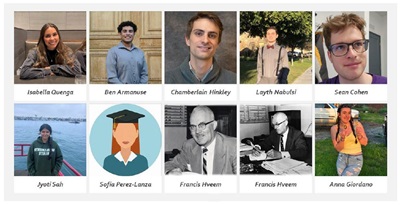
Headquarters photograph
By the Division of Engineering Services
(subdivision of Materials Engineering and Testing Services)
Eight prospective future leaders in the transportation industry have been named the 2023 Hveem Scholarship winners. The Francis N. Hveem Memorial Scholarship honors the late Francis N. Hveem, former state materials engineer and chief of the Materials and Research Laboratory in Sacramento.
The Transportation Laboratory (TransLab) has undergone several reorganizations since Hveem retired but still serves as the hub of materials engineering excellence for Caltrans.
Hveem was a civil engineer specializing in materials. His contributions to highway engineering have been known worldwide and helped guide the TransLab to international renown.
The scholarship fund was originally established by a generous bequest from the Hveem family and contributions by TransLab employees. The fund is regularly augmented through donations and fundraisers to ensure that scholarships may continue to be awarded.
The purpose of the scholarship is to assist and encourage individuals who are preparing for careers in technical fields that could lead to future employment in materials engineering. Annually, the Francis N. Hveem Memorial Scholarship committee gets together to select finalists who meet the eligibility criteria.
We are very excited to announce this year’s Hveem Scholarship winners:
- Ben Armanuse
- Sean Cohen
- Anna Giordano
- Chamberlain Hinkley
- Layth Nabulsi
- Sofia Perez-Lanza
- Isabella Quenga
- Jyoti Sah
These eight winners have shown such passion to learning and their community. It is a real pleasure to provide them with a scholarship of $1,000 each.
To learn more about or donate to the Hveem Scholarship fund, visit this webpage.
Hats Off
Roundabouts, District 5 hailed as triumphant
“The new Roundabouts at Olive Mill Road (above) and San Ysidro Road (below) in Santa Barbara County are a ‘work of art’ and I’m very happy with the outcome of these projects and I think Caltrans District 5 is great,” emailed Larry Parsons of Montecito.
Health and Safety
Five tips to support youth mental health

By the Employee Assistance Program
Youth mental health is essential to their overall health and well-being.
Child behaviors and emotions can change frequently and rapidly, making it difficult for parents and teachers to detect mental, behavioral or emotional issues right away. Studies find that an estimated 70 to 80 percent of children with mental health disorders go without care.
The following tips can help you nurture the mental health of your child or young person in your life.
1. Be intentional and attuned. Paying close attention to verbal and nonverbal cues can help you know when a child needs support or someone to talk with.
2. Foster closeness. Seeking out opportunities to lead with empathy and nurturing a close relationship can make it easier for a child to come to you when they are having a problem.
3. Encourage connections. Building relationships helps children learn to be better friends and develop critical social skills, such as reading and responding to nonverbal cues. Social health is essential for positive mental health.
4. Model good behavior. Being open about your feelings without oversharing details shows how to recognize, manage and learn from difficult emotions.
5. Make healthy choices. Encouraging eating nutritious foods, exercising regularly, and getting adequate sleep can protect against mental health issues and improve mood.
Youth mental health issues are real, common and treatable. While some problems are short-lived and don’t need treatment, others are ongoing and may be very serious. If you are concerned about changes in behavior or other symptoms, consult your EAP or a doctor.
The EAP is here to provide you with compassionate and caring support. Learn more on the EAP website or call1-800-EAP-4SOC (1-866-327-4762) TTY: 711 to get started.
Who’s New
Angel Alvarado, Headquarters CPRA coordinator
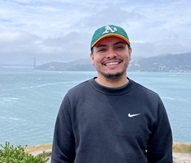
Angel Alvarado
Angel Alvarado has joined Headquarters Public Affairs as the California Public Records Act (CPRA) coordinator.
His responsibilities include statewide oversight on routine and sensitive CPRA requests.
Angel has a bachelor’s degree in kinesiology-sports management from Saint Mary’s College of California. He joins Public Affairs after two years working for the Department of Procurement and Contracts (DPAC) in the Property Control unit.
Before state service, he was with the Capital Athletic Club, handling marketing and membership. He has also worked in community relations with the San Francisco 49ers and public relations with the Stockton Kings.
Angel enjoys going to concerts, trips, golfing and sporting events. He is excited about this opportunity and looks forward to meeting everyone.
Chris Clark, Public Affairs deputy division chief

Chris Clark
Chris Clark has been promoted to Public Affairs deputy division chief, overseeing media.
Chris has served most recently as the Middle Mile Broadband Initiative (MMBI) media specialist after previously working in 2020-21 as the Public Affairs media relations manager, where he specialized in public relations, media strategy and crisis communications.
Prior to public service, Chris spent 20 years as a front office executive in professional sports and served as communications director for two U.S. congressional campaigns.
A lifelong Sacramentan, he enjoys watching baseball, outdoor recreation, and spending time with his wife, Nicolette, and their 3-year-old daughter, Olivia.
Wajahat Nyaz, deputy district director, District 4 Division of Design

Wajahat Nyaz
Wajahat Nyaz is the new deputy district director for the District 4 Division of Design.
In this role, Wajahat will oversee the district’s four Design regions: Design North, Design South/West, Design East, and Design Services. Within these Design Divisions are the Office of Materials & Pavement, Office of Hydraulic Engineering, Office of Landscape Architecture, and Utility Engineering, which provide specific technical expertise.
Division of Design prepares products such as plans, specifications, estimates (PS&E), project approval reports, and technical recommendations for a variety of transportation, storm damage and habitat restoration projects. Division of Design also provides construction support and performs independent quality assurance of locally funded and local tax measure transportation projects on the state highway system in nine Bay Area counties.
Wajahat has more than 32 years of diverse experience designing, constructing and managing transportation infrastructure projects. He started his career in Caltrans District 4 in 1991 as a transportation engineer, completed the rotation program, and moved to private industry, where he worked as a project engineer for four years.
He rejoined Caltrans in 1998 and worked as a project engineer and senior engineer in the Division of Engineering Services (DES) until 2007 on several high-profile projects, including the San Francisco Bay Bridge seismic retrofit, Devil’s slide emergency repair, and the Interstate 880/State Route 92 interchange projects.
Wajahat joined the District 4 Division of Program/Project Management in 1998. He served as the regional project manager of Marin County and the corridor manager for the high-profile Marin-Sonoma Narrows projects until 2021.
From 2021 to 2023, Wajahat was the director of projects for Alameda CTC, overseeing Alameda CTC’s multibillion-dollar portfolio of active capital projects and transportation improvements in various delivery stages.
Wajahat returned to Caltrans District 4 as a division chief of Design East in 2023, overseeing Design East and West and the Office of Landscape Architecture.
Wajahat has a master’s of science degree in civil engineering from the South Dakota School of Mines and Technology, and master’s degree in Transportation Management from San Jose State University.
He is also a registered civil and geotechnical engineer in California and a Project Management Institute-certified project manager.
Nailah Pope-Harden, deputy director of Equity and Tribal Affairs

Nailah Pope-Harden
Nailah Pope-Harden is the new deputy director of Equity and Tribal Affairs as part of the Director’s Office of Equity, Sustainability and Tribal Affairs (ESTA) being reorganized.
The Office of Equity and Tribal Affairs will take over ESTA’s Native American Liaison and Race & Equity branches, and be housed in the director’s office.
Nailah has been executive director at ClimatePlan since 2021 and was a policy manager there from 2019 to 2021. ClimatePlan is a partnership that works across California to improve land-use and transportation planning with a focus on protecting health, communities and climate.
At ClimatePlan, Nailah was responsible for expanding the network presence, cultivating new members, and ensuring the mission and vision of the organization was being carried out.
Nailah has been principal at Nailah Consulting since 2012, specializing in multi-racial, multi-generational campaigns.
Nailah was an organizer at the Capital Region Organizing Project from 2016 to 2017 and a parent organizer at the California Charter Schools Association in 2015. She is a member of the New Leaders Council, serves on the board of America Walks, and recently started a professional development group for women of color in environmental professions.
Nailah has spent more than 15 years advocating for transportation justice, racial equity, environmental justice and climate action. She comes to this position with years of experience in community organizing and coalition building. Her advocacy work spans across neighborhoods, regional, statewide, and national campaigns.
Of the over 40 campaigns she has participated in, Nailah finds the most joy in planning community events in the south Sacramento neighborhoods she grew up in.
Nailah earned a bachelor of science degree in government from California State University, Sacramento, and resides in south Sacramento with her 5-year-old son. Together, they enjoy playing in the backyard, reading books, singing and dancing.
Nailah’s personal and professional life is always ensuring her son has a healthy, safe, loving environment and future. She does this by building community everywhere she goes, learning from those around her, and being open to (transformative) change.
Eric Sundquist, deputy director for Sustainability
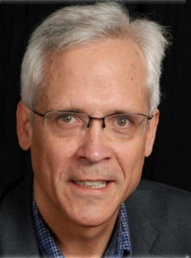
Eric Sundquist
Eric Sundquist has been appointed deputy director for Sustainability as part of the Director’s Office of Equity, Sustainability and Tribal Affairs (ESTA) being reorganized.
The Office of Sustainability will include zero-emissions vehicles, vehicle-miles traveled reduction, complete streets, climate strategy and sustainable facilities, and will be housed in the director’s office.
Eric joined Caltrans in 2021 serving as the sustainability adviser in ESTA. In that role Eric led the department’s effort to evaluate and minimize vehicle-miles traveled in assessing project transportation impacts, and in developing metrics around equitable multimodal access to destinations.
Prior to Caltrans, Eric was director of the State Smart Transportation Initiative (SSTI) at the University of Wisconsin, Madison, from 2010 to 2021 and a senior associate there from 2007 to 2010. SSTI works with state DOTs nationally to modernize policy and practice around policy goals including environmental protection, equitable transportation service and impacts, and cost-savings.
Eric has been active in the Transportation Research Board, chairing the Social, Economic, and Cultural Issues Section and serving as an officer on the Major Cities and Transportation and Sustainable Transportation committees.
Eric held several positions at the Georgia Institute of Technology including research scientist from 2004 to 2007 and research and teaching assistant from 2003 to 2004.
He held editor and reporter positions at several publications, including the Atlanta Journal-Constitution, the (Norfolk) Virginian Pilot, the (Fredericksburg, Va.) Free Lance-Star, the Richmond Times-Dispatch, and the (Newport News, Va.) Daily Press and Times Herald from 1981 to 2007.
Eric has a bachelor of arts degree in English from Miami University of Ohio, a master of humanities degree from the University of Richmond, a master of science degree in public policy from the Georgia Institute of Technology and a doctor of philosophy degree in city planning from the Georgia Institute of Technology.
Eric is a long-time bike commuter. He first visited California in 1988 on a cross-country bike trip and is planning to do a 400-mile group ride – the (Des Moines) Register's Annual Great Bicycle Ride Across Iowa, or RAGBRAI – in July.
Russ Watts, chief information security and privacy officer

Russ Watts
Russ Watts is Caltrans’ new chief information security and privacy officer.
Russ has served Caltrans Information Technology for the past 14 years in various capacities, most recently as the deputy division chief over Infrastructure Services, where he oversaw the complex operations for server hosting, storage/data protection, database/middleware, and network operations/network engineering.
Russ has also served in various roles for California Fish and Wildlife, California Student Aid Commission, as well as more than two decades of consulting practice in the private sector.
Russ is an active outdoors enthusiast, enjoys any form of competitive activity, and likes spending time with friends and family.
Obituaries
Andrew L. Hough, retired Caltrans engineer

Courtesy of Andrew's family
Note: The following obituary appeared on DignityMemorial.com.
Retired Caltrans engineer Andrew L. Hough, 65, of Fair Oaks passed away on Dec. 17, 2023.
He was born on March 31, 1958 in San Juan, Puerto Rico, the son of Allen and Sally Hough, and was the second of four siblings.
His family and friends called him Andy. In 2012, he married and is survived by his wife, Ying Li Hough.
Andy was educated at Cincinnati Country Day School, and graduated from Bradley University (Illinois) in engineering. He joined Caltrans in the mid-1980s and worked there for many decades until illness forced his retirement a few years ago.
He has been active in giving yearly gifts to a variety of charities across the country. He was a very sensitive and caring person and family was very important to him. He made it a priority to keep in communication with family and for those he cared deeply.
Andy is survived by his wife, Ying Li Hough; his daughter, Tiana Hough; his father and second mother, Allen and Cay Hough; his sisters Mary Hough, Melissa Hough, Jane Fontaine; his brothers, Lexy Hough, John Hough, Jason Hough, Jay Hough; and previous wives, Cheryl Beardsley, Marie Finn, Debra Johnson. Andy is preceded in death by his mother, Sarah Hough.
Dexter S. Luther, retired Caltrans electrician
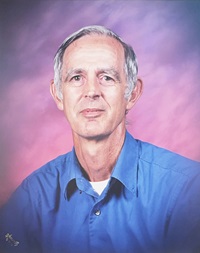
Courtesy of Dexter's family
Note: The following obituary appeared in the Lost Coast Outpost on Feb. 3.
Dexter Slade Luther was born in the General hospital, in Eureka, on May 3, 1945, to parents William Slade Ide Luther and Erna Dunton Luther. He was their fifth child, and the baby of the family. He died at home on Jan. 23 at age 78.
Dexter graduated from Eureka Senior High in 1963, and attended Humboldt State College for a couple of years before joining the Air Force. He wanted to work in electronics, but tested high in mechanical aptitude, and spent his time in the military in Germany, maintaining electro-mechanical telephone switching equipment.
Upon discharge from the military, Dexter worked for a local television station, first manning their remote transmitter, and later in equipment maintenance. After a few years of working long hours for a small salary, Dexter went to work as an electrician for Caltrans.
His 30-plus year career at Caltrans started in San Bernardino, and included a short stay in Stockton before he returned to Eureka.
Retiring from Caltrans didn’t end Dexter’s career as an electrician. He was a life member of the Timber Heritage Association, and spent several afternoons a week at their Samoa facility, often as their volunteer electrician. Visiting relatives would often be invited to tour the historic logging equipment and railroad memorabilia of the Timber Heritage Association.
Dexter was an amateur radio operator, and a lifetime member of the Congregational church.
Dexter was preceded in death by his parents, and his sisters, Maybelle Luther, Mary’l (Don) Atterbury, and Grace (Roy) Summers. He is survived by his brother, Guy (Judy) Luther, and numerous nieces and nephews.
Doug MacIvor, retired transportation planner
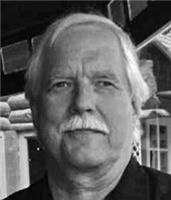
Courtesy of Doug's family
Douglas (Doug) MacIvor passed away on Feb. 23 in Cebu, Philippines, one day shy of his 67th birthday.
Doug worked for approximately 38 years for Caltrans in District 3 and Headquarters in the Division of Transportation Planning.
While in District 3 he pioneered microsimulation modeling integration into transportation planning. He was the lead microsimulation modeler for the North Region on projects that included the Willits Bypass, Lincoln Bypass, and the Eureka to Arcata Corridor.
In Headquarters’ Office of Travel Modeling and Forecasting and Analysis, he initiated the development and funding of the Statewide Freight Forecasting Model, which has now been integrated with the Interregional Statewide Travel Demand Model, while working closely with the California Air Resources Board (CARB) and the Transportation Research Board.
Doug also was a key team member in the development of the Statewide Travel Demand Model and the 2012 California Household Travel Survey.
Doug was well known for his sense of humor under any given situation and his ability to make friends wherever he went.
Doug was born to Donald and Isabel (Weber) MacIvor in San Francisco
The MacIvors were a military family and lived in Monterey, Germany, and San Bruno before moving to Yuba City.
Doug was an Eagle Scout. He graduated from Yuba City High School in 1975, before attending Yuba College, where he served on the student council. He then earned a bachelor's degree from California State University, Chico.
Doug retired as a senior transportation planner in charge of Statewide Microsimulation Modeling. He represented Caltrans as a member of the Transportation Research Board in Washington, D.C.
Doug was a voracious reader, with an incredible memory and a deep interest in history. He loved to travel to historic places such as Revolutionary and Civil War battlefields, national parks, historic railroad rides, including Ontario and the Great Lakes region.
He and his loyal guide dogs, Ridgely, Teal and Godfrey, seemed to make new friends everywhere they went.
He was a member of the St. James Episcopal Church, SIRS, and the Loyal Order of Moose.
Doug is survived by his daughter, Jennifer Reimer; and son, William MacIvor; both of Redding, and eight grandchildren.
- All-in-one version
- Director's Corner
- DOT Shots
- Hats Off
- Health and Safety
- News
- Obituaries
- Retirements
- Service Awards
- Who's New


